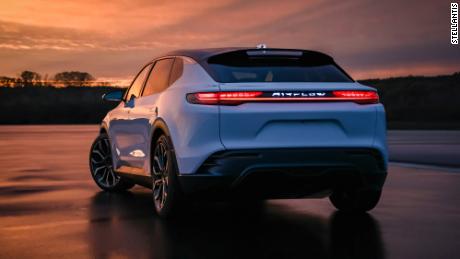Tavares is approaching his one year anniversary leading Stellantis, a company formed on January 16, 2021, through the merger of the two automakers. The sprawling company, officially headquartered in the Netherlands, sells cars, trucks and SUVs under 14 different brands, including Dodge, Fiat, Ram, Jeep, Chrysler, Citroën and Peugeot.
Stellantis currently offers 18 different electric models across various brands, almost all in Europe. All were introduced over the past two years, and most are electric versions of gasoline-powered cars, crossovers and vans. The company plans to add eight more electric models in the next year and a half but, for now, offers no fully electric vehicles at all in the US.
Tesla sold nearly a million electric vehicles in 2021, and electric offerings from major players like Ford, Volkswagen, General Motors and Mercedes have all hit showroom floors. In many cases, those brands have also seen strong sales.
But Stellantis has big plans for electric vehicles and, in an interview with CNN Business, Tavares insisted that being a little late to the game can have its advantages.
For instance, Stellantis doesn’t expect to have an electric pickup in the US market until 2024. That means its engineers and designers get to take a good, hard look at the Ford F-150 Lightning, entering production in a few months, and at General Motors’ Chevrolet Silverado EV, just recently revealed and going into production next year. Tesla is also supposed to be coming out with its Cybertruck pickup eventually, but after years of delays the company no longer has a publicly stated firm production date. Tesla did not respond to an email seeking an update.
The Ram 1500 EV will come out after others are already on the market but, Tavares promises, Stellantis is using the time well.
“So I’m not saying that it’s good to be number two or number three in terms of timing,” Tavares said. “I’m just saying, that if this is the situation in which I am, I would be stupid not to leverage that to make the best truck of the market.”
Tavares insists that Stellantis is pursuing electrification aggressively, despite the fact that he has questions about its long term efficacy. Electric cars don’t represent a solution to the climate crisis on their own, he points out, but only when and where electric power is generated without emissions. Otherwise we’re just polluting differently. Also, the added weight of electric cars — battery packs are very heavy — is a testament to their demand for raw materials and exotic metals which can cause ethical and environmental problems, too, he said.
For now, electric cars seem like the best option but, he said, in a few decades something better may present itself
“If you step back and you don’t look at it in the time window of the next 10 years, [but] you look at it in a time window of 30 or 40 years, who knows?” he said.
For now, electric cars seem like the way to go, so Stellantis is in.
“We are sincere in the fact that there is no other better solution right now than electrification,” he said. “And we go full speed and we go full power on that direction.”
So far Stellantis hasn’t committed to becoming fully electric by any specific date. While GM has said it will sell nothing but zero emission vehicles — presumably most of them battery-powered electric cars — by 2035, Stellantis has only said that 40% of the vehicles it sells in the United States will be electric and 70% in Europe by 2030.
Stellantis will present a more detailed strategy on March 1, 2022. Some plans have already been made public. For instance, at the Consumer Electronics Show in Las Vegas earlier this month, it was announced that Chrysler will become a fully electric car brand in 2028, three years after its first electric model comes out.
And while it may not be first with an electric truck or SUV, Stellantis’ Dodge brand will be first with an electric muscle car, which is expected in 2024.
“I can tell you are going to fall in love with that because the cars are fantastic,” Tavares said. “My God. I am just so impatient to see those cars rolling on the US highways.”



